 Click To Return To Main Page |
 |
||||||||
 News |
 Eco-Journalists |
 Articles |
 Games |
 Links |
 Facts 'n Fun |
 Email Us |
 About Us |
 Guestbook |
|
|
Find Your Prince
They say you have to kiss a lot of frogs to find your prince...well, we can't guarantee you a prince, but we can show you how to get lots of frogs (which we reckon is better anyhow)  You may be asking "why should I have a frog pond in my garden?" Our garden backs onto some bushland and a creek. We noticed that the croaking we heard each summer from the creek was getting less and less. There has been a lot of new houses built in our area and the developers have just cut all the trees and bushes down (rotters!). This means that the frogs (and other animals) have lost their habitat. The creeks have also become more polluted so we were getting worried that because of all of this, that the frog numbers were getting very low.
You may be asking "why should I have a frog pond in my garden?" Our garden backs onto some bushland and a creek. We noticed that the croaking we heard each summer from the creek was getting less and less. There has been a lot of new houses built in our area and the developers have just cut all the trees and bushes down (rotters!). This means that the frogs (and other animals) have lost their habitat. The creeks have also become more polluted so we were getting worried that because of all of this, that the frog numbers were getting very low.
So we decided to build a frog pond. You could build one too...it was pretty easy and it's great to hear the frogs in our pond at night...although Freya hates it as the pond is next to her bedroom. Planet Patrol Big Tip no.1 - don't build your frog pond next to your bedroom window! 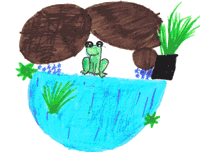 Therefore, the answer to 'why should I have a frog pond in my garden?' is because:
Therefore, the answer to 'why should I have a frog pond in my garden?' is because:
How to build a frog pond
1. There are two methods of pond-building. Either (1) plastic lining or (2) a readymade, hard plastic/fibreglass pond (like we have). We chose the plastic moulded pond because it looks better than black plastic but with the black plastic, you can choose the design, the shape and the size of your frog pond...and it's much, much cheaper! 2. Plan where you're going to locate your pond (see PP Big Tip no.1!). Make sure it's in a position where you can easily get to it - you'll need to clean it and maintain it. Make sure that it's not in a sunny area as frogs like to be in a shady, moist area. 3. Mark the outline - we used some string. Then dig a large hole to suit the design of your pond. If you are using a plastic sheet liner, then make sure you don't make the sides steep - frogs can't climb up slippy slopes very well. Try to build a ledge around the pond sides about half-way up. Making sure the pond is level
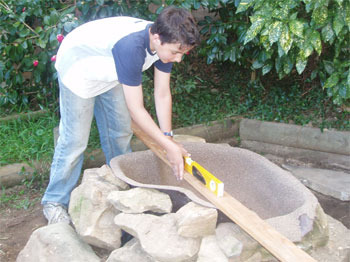 4. Insert the lining or plastic pond. Make sure that the rim of the pond is level! If not, the water will leak over the lower side. We did this by using a builders' spirit level. You might want to get an adult to help with this bit as it was really tricky and took ages. We placed a plank across the top of the pond and put the level on and adjusted it till the bubble of air in the level was sitting right in the middle of the window. Then we had to change the direction of the level across the pond - eventually it was level in all directions. 4. Insert the lining or plastic pond. Make sure that the rim of the pond is level! If not, the water will leak over the lower side. We did this by using a builders' spirit level. You might want to get an adult to help with this bit as it was really tricky and took ages. We placed a plank across the top of the pond and put the level on and adjusted it till the bubble of air in the level was sitting right in the middle of the window. Then we had to change the direction of the level across the pond - eventually it was level in all directions.
Adding the water pump
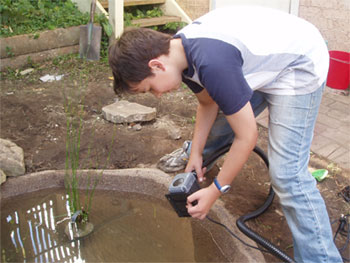 5. Add any fountains, waterfalls or other features. A water pump circulates the water and this helps keep it clean, oxygenated (puts air in the water which the fish and other water-insects need). Also, mosquitoes lay their eggs in stagnant water and the pump will prevent this by keeping the water moving. Make sure the electricity supply is safe...water and electricity DO NOT mix! Get an adult to help. 5. Add any fountains, waterfalls or other features. A water pump circulates the water and this helps keep it clean, oxygenated (puts air in the water which the fish and other water-insects need). Also, mosquitoes lay their eggs in stagnant water and the pump will prevent this by keeping the water moving. Make sure the electricity supply is safe...water and electricity DO NOT mix! Get an adult to help.
We added an extra smaller pond above the main pond. We went to a pond supply shop and bought: This water then fills the top pond and cascades over the lip into the bottom pond. This is lovely and it makes a nice damp environment for the froggies. Planting a frog-friendly habitat around the edge of the pond
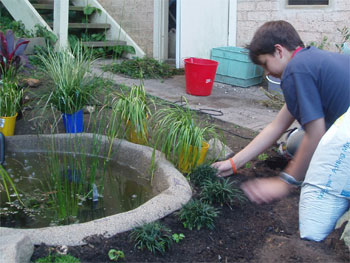 6. Fill your pond with water. (Don't put any frogs/tadpoles or fish in straight away unless you have bought some 'water conditioner' from a pet shop. You need to wait for at least a couple of days at least otherwise the chemicals will kill them.
6. Fill your pond with water. (Don't put any frogs/tadpoles or fish in straight away unless you have bought some 'water conditioner' from a pet shop. You need to wait for at least a couple of days at least otherwise the chemicals will kill them.
7. Add plenty of rocks around the edges of the pond. This is really, really important - frogs won't live in your pond unless you do this. Make sure there are lots of gaps for the frogs to hide in during the day as frogs are mostly nocturnal (they come out at night). 8. Wait....frogs will find your pond by themselves. If you have so few frogs in your area that they're having problems finding you, you could always ask someone for some tadpoles or look in a local creek or lake. Frogs only like slow flowing or still water. It's preferable to wait for frogs to find you as then you are getting the right frogs which are natural to your area. 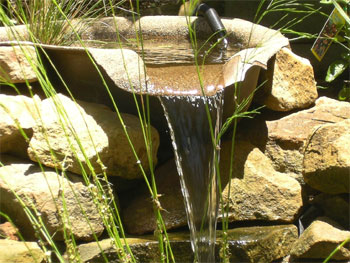 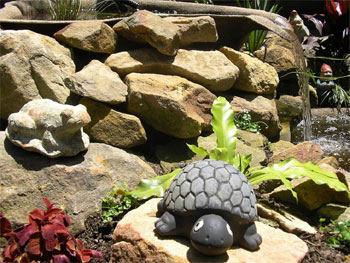
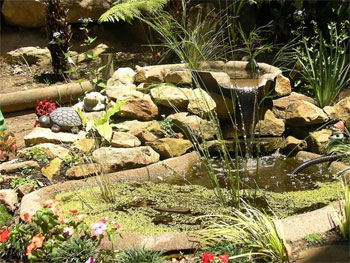 Story by Alastair and Imogen
|